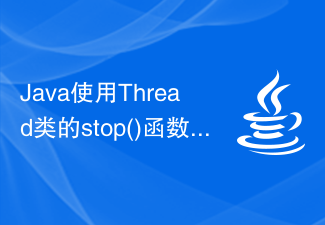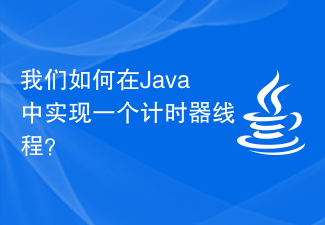5 stages: 1. New, which is the thread that has just been created using the new method; 2. Ready, which is after calling the start() method of the thread. At this time, the thread is in the stage of waiting for the CPU to allocate resources; 3. Running, when the ready thread is scheduled and obtains CPU resources, it enters the running state; 4. Blocking, in the running state, the thread in the running state may become blocked due to some reasons; 5. Destruction , after the thread completes normal execution or the thread is forcibly terminated in advance or an exception occurs, the thread will be destroyed.

The operating environment of this tutorial: Windows 7 system, Dell G3 computer.
The life cycle of a thread consists of 5 stages, including: new, ready, running, blocked, and destroyed. The complete life cycle diagram is as follows:

When a thread enters the running state, the general operating system uses a preemptive method to allow the thread to obtain the CPU. Therefore, the CPU needs to switch between multiple threads, so the thread status will switch between running, blocked, and ready multiple times.
##New : Use the new method, new comes out Thread, at this time, only the JAVA virtual machine allocates memory for it and initializes the values of member variables. It is just an object at this time.
Ready: It is called After the thread's start() method, the thread is in the stage of waiting for the CPU to allocate resources. Whoever grabs the CPU resources first will start execution; The thread enters the ready state, and
the JAVA virtual machine creates a method call stack for it and program counter . The execution of threads is controlled by the underlying platform and has a certain degree of randomness.
: When the ready thread is scheduled When the CPU resource is obtained, it enters the running state. The run method defines the operation and function of the thread; (when the thread in the ready state obtains the CPU, it will execute the run() method) For a single-core CPU (or (a core), it can only execute one instruction at the same time, and the JVM achieves multi-threading by quickly switching threads to execute instructions. A real processor can process one instruction at the same time, but this switching speed is very fast, and we will not do it at all. perceived. In order to restore the correct execution position after thread switching, each thread has an independent program counter. The counters between each thread do not affect each other and are stored independently. When a thread starts running, it cannot hold the CPU all the time (unless the thread execution body is very short and the execution ends instantly). Therefore, the thread needs to be interrupted during execution in order to allow other threads to gain access to the CPU for execution. The details of thread scheduling depend on the strategy adopted by the underlying platform.
4. Blocked Blocked: In the running state, it may occur due to some reasons The running thread becomes blocked. The reasons are as follows:
1.等待I/O流的输入输出 2.等待网络资源,即网速问题 3.调用sleep()方法,需要等sleep时间结束 4.调用wait()方法,需要调用notify()唤醒线程 5.其他线程执行join()方法,当前线程则会阻塞,需要等其他线程执行完。
The state switching diagram is as follows:
5. Destroyed (terminated )If the thread completes normal execution or the thread is forcibly terminated in advance or an exception occurs, the thread will be destroyed and resources will be released.
1. The run()/call() method is executed and the thread ends normally;
2. The thread throws an uncaught Exception or Error; 3. Directly call the thread's stop( ) method to end the thread - this method can easily lead to deadlock and is generally not recommended.
Extended knowledge: CPU time slice There is a crystal oscillator at the operating system level, which is a bit like a monk ringing a bell every few seconds. Collision occurs once in a short period of time, dividing the CPU time into time slices; each thread actually keeps grabbing time slices one by one; after the time slice reaches the point, it still has to grab it again (to ensure that all Threads have the opportunity to grab the CPU to execute their own logic; fairness)
New state
Let’s look at the following piece of code:
Thread t1 = new Thread();
The creation here is just It is created at the programming language level of JAVA, but at the operating system level, the real thread has not yet been created. Only when we call the start() method will the thread be created and enter the Runnable state. Only when we call the start() method will the thread be created
For more related knowledge, please visit the
FAQThe above is the detailed content of The life cycle of a thread is divided into several stages. For more information, please follow other related articles on the PHP Chinese website!
 8核16线程是什么意思?Feb 02, 2023 am 11:26 AM
8核16线程是什么意思?Feb 02, 2023 am 11:26 AM8核是指CPU有8颗物理核心,16线程是指CPU最多同时可以有16个线程处理任务。核心数和线程数是电脑CPU的重要性能指标,CPU的核心数越高处理速度就越高;线程数越多越有利于同时运行多个程序,因为线程数等同于在某个瞬间CPU能同时并行处理的任务数。多线程可最大限度地实现宽发射、乱序的超标量处理,提高处理器运算部件的利用率,缓和由于数据相关或Cache未命中带来的访问内存延时。
 Java错误:JavaFX线程卡顿错误,如何处理和避免Jun 24, 2023 pm 05:52 PM
Java错误:JavaFX线程卡顿错误,如何处理和避免Jun 24, 2023 pm 05:52 PM在进行JavaFX应用程序开发的过程中,我们常常会遇到JavaFX线程卡顿错误。这种错误的严重程度不同,可能会对程序的稳定性和性能产生不利的影响。为了保证程序的正常运行,我们需要了解JavaFX线程卡顿错误的原因和解决方法,以及如何预防这种错误的发生。一、JavaFX线程卡顿错误的原因JavaFX是一个多线程的UI应用程序框架,它允许程序在后台线程中执行长时
 什么是程序运行时指令流的最小单位Aug 23, 2022 pm 02:16 PM
什么是程序运行时指令流的最小单位Aug 23, 2022 pm 02:16 PM“线程”是程序运行时指令流的最小单位。进程是指一个具有一定独立功能的程序,而线程是进程的一部分,描述指令流执行状态;线程是进程中的指令执行流的最小单位,是CPU调度的基本单位。一个线程是一个任务(一个程序段)的一次执行过程;线程不占有内存空间,它包括在进程的内存空间中。在同一个进程内,多个线程共享进程的资源;一个进程至少有一个线程。
 Go语言中线程和进程的区别解析Apr 03, 2024 pm 01:39 PM
Go语言中线程和进程的区别解析Apr 03, 2024 pm 01:39 PMGo语言中的进程和线程:进程:独立运行的程序实例,拥有自己的资源和地址空间。线程:进程内的执行单元,共享进程资源和地址空间。特点:进程:开销大,隔离性好,独立调度。线程:开销小,共享资源,内部调度。实战案例:进程:隔离长时间运行的任务。线程:并发处理大量数据。
 go语言中协程与线程的区别是什么Feb 02, 2023 pm 06:10 PM
go语言中协程与线程的区别是什么Feb 02, 2023 pm 06:10 PM区别:1、一个线程可以多个协程,一个进程也可以单独拥有多个协程;2、线程是同步机制,而协程则是异步;3、协程能保留上一次调用时的状态,线程不行;4、线程是抢占式,协程是非抢占式的;5、线程是被分割的CPU资源,协程是组织好的代码流程,协程需要线程来承载运行。
 Java使用Thread类的stop()函数强制终止线程的执行Jul 26, 2023 am 09:28 AM
Java使用Thread类的stop()函数强制终止线程的执行Jul 26, 2023 am 09:28 AMJava使用Thread类的stop()函数强制终止线程的执行在Java多线程编程中,有时候我们需要强制终止一个正在执行的线程。Java提供了Thread类的stop()函数来实现线程的强制终止。本文将介绍stop()函数的用法,并提供代码示例来说明。在介绍stop()函数之前,我们先了解一下Thread类的几个常用方法:start():启动线程,使线程进入
 Microsoft计划在Windows上的Outlook经典应用程序中引入AI驱动的CopilotOct 19, 2023 pm 11:13 PM
Microsoft计划在Windows上的Outlook经典应用程序中引入AI驱动的CopilotOct 19, 2023 pm 11:13 PMMicrosoft显然不会将其强大的人工智能支持的Copilot工具保留为新应用程序的独家功能。现在,该公司刚刚宣布计划在Windows上的Outlook经典应用程序中引入Copilot。正如其365路线图网站上发布的那样,预览将于明年<>月开始,直到<>月在当前频道的桌面上在全球范围内推出。Copilot是一种生产力工具,它使用大型语言模型(LLM)来帮助用户完成编写电子邮件、汇总文档和翻译语言等任务。它的主要功能之一是它能够总结电子邮件
 我们如何在Java中实现一个计时器线程?Aug 30, 2023 pm 02:49 PM
我们如何在Java中实现一个计时器线程?Aug 30, 2023 pm 02:49 PMTimer类安排任务在给定时间运行一次或重复。它还可以作为守护线程在后台运行。要将Timer与守护线程关联起来,需要使用一个带有布尔值的构造函数。计时器以固定延迟和固定速率安排任务。在固定延迟下,如果任何一个执行被系统GC延迟,则其他执行也会延迟,并且每次执行都会延迟对应于之前的执行。在固定速率下,如果任何执行被系统GC延迟,则连续发生2-3次执行以覆盖与第一次执行开始时间相对应的固定速率。Timer类提供了cancel()方法来取消计时器。当调用该方法时,定时器终止。Timer类仅执行实现Ti

Hot AI Tools

Undresser.AI Undress
AI-powered app for creating realistic nude photos

AI Clothes Remover
Online AI tool for removing clothes from photos.

Undress AI Tool
Undress images for free

Clothoff.io
AI clothes remover

AI Hentai Generator
Generate AI Hentai for free.

Hot Article

Hot Tools

SublimeText3 Chinese version
Chinese version, very easy to use

Dreamweaver Mac version
Visual web development tools

WebStorm Mac version
Useful JavaScript development tools

Notepad++7.3.1
Easy-to-use and free code editor

SecLists
SecLists is the ultimate security tester's companion. It is a collection of various types of lists that are frequently used during security assessments, all in one place. SecLists helps make security testing more efficient and productive by conveniently providing all the lists a security tester might need. List types include usernames, passwords, URLs, fuzzing payloads, sensitive data patterns, web shells, and more. The tester can simply pull this repository onto a new test machine and he will have access to every type of list he needs.







